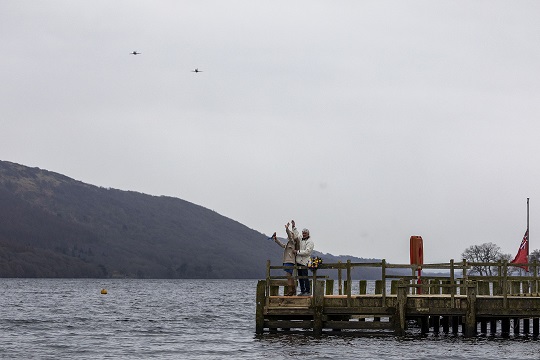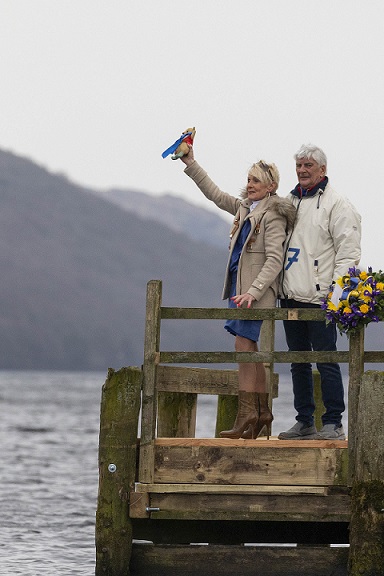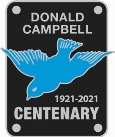
RAF Jets Pay Tribute to Donald Campbell CBE on the Anniversary of His Birth
UNITED KINGDOM / AGILITYPR.NEWS / March 23, 2021 / Two RAF Hawks from IV(AC) Squadron based at RAF Valley in Anglesey, dipped their wings in salute today to mark the 100th anniversary of the birth of speed legend Donald Campbell CBE , and to pay respect to his daughter Gina who laid flowers on Coniston Water as they roared overhead.
It was an emotive moment for Gina and a small group of Trustees from the Ruskin Museum, home for his record-breaking boat Bluebird K7. The jets flew over the lake and repeated a tribute that had been carried out by a Vulcan bomber the day after his death on January 4th, 1967.
Gina said: “ I am touched by the RAF’s mark of respect and their act was a fitting tribute to my father who would have been thrilled by the gesture. I cannot thank the RAF and the crews who flew today enough for their thoughtful tribute, especially Ft/Lt. Eddie Craig who led the flypast from 4 AC Squadron at RAF valley.”
She added: “ My father is buried in Coniston, but it is also his spiritual home and every year thousands of people visit the Ruskin Museum to learn more about his incredible journey through life, gaining speed records on both land and water.
“He loved Coniston and its people as I have done over the years and having a museum that tells the story is a lasting tribute. We hope that soon Bluebird K7 which my family gifted the museum will return to Coniston.”
Flt Lt Eddie Craig who is a qualified Flying Instructor, with IV(AC) Sqn at RAF valley and who led the flypast said: "It is a huge honour to continue the RAF tradition of paying tribute to Donald Campbell and celebrate, not only his achievements, but also his spirit of courage and determination.
“Today we flew 2 Hawk T2 aircraft from RAF Valley which are used to train the next generation of fighter pilots for the RAF and Royal Navy. Whist conducting the flypast is a great spectacle for people on the ground, it also provides important low level training for our student pilots. Our top speed as we flew up Coniston Water was 480mph which we hope Donald would have approved of."
Jeff Carroll from the Ruskin museum which owns K7 said: “Keeping Donald Campbell’s memory alive and enabling people from around the world to visit Coniston and learn about his achievements is telling an important chapter in the history of Coniston, and indeed the United Kingdom. Coniston is extremely proud of its association with its adopted son, and the world beating achievements reached on our lake.
“Both Donald and his father, Sir Malcom had a deep affection for Coniston and its people. It is our honour and privilege to honour what would have been Donald’s 100th Birthday today in the best way we can, given the current restrictions.”
Gina and Trustees from the museum then visited her father’s grave in Coniston Churchyard.


Notes:
Born on March 23rd, 1921, the Speed Ace Donald Campbell was Britain’s blue-eyed boy of World Water Speed Record-breaking in the 1950s. His matinee idol looks brought glamour to the grey years of post-War austerity. His Bluebird K7 encapsulated the technological promise of the Festival of Britain. And between 1955 and 1959 he broke the outright World Water Speed Record on six separate occasions, four of them on Coniston Water. These were the golden years, when Fortune smiled on him.
In the 1960s, he turned his attention to the World Land Speed Record, once monopolised by his father, Sir Malcolm Campbell. In 1960 he had a disastrous crash at Utah which had a permanent effect on his physical and mental health.
On Thursday 7th December 2006, Gina Campbell formally gifted Bluebird K7 to the Ruskin Museum. Gina Campbell commented: "I've decided to secure the future of Bluebird for the people of Coniston, the Ruskin Museum and the people of the world". In agreement with the Campbell Heritage Trust and the Museum, Bill Smith and his team then started work on the restoration of K7.
The Double
It was 1964, in Australia, before he was able to make another – and this time successful – run, which he followed by raising the World Water Speed Record to 276.33 mph on Lake Dumbleyung in Western Australia, on the very last day of the year. He may have cut it fine, but he remains the only person to have broken both the World Land and World Water Speed Records in the same year. The achievement is unlikely to be equalled.
1964 should have been his annus mirabilis, but, somehow, his unique and inimitable double success was never registered by the British public.
The press had turned against him, finding land and water speed records distinctly passe now Man was in space. And, anyway, the Americans had gone much faster on land in rocket-powered vehicles, even if they weren’t wheel-driven : the rules were too old-fashioned, too nonsensical. Campbell was an anachronism
Bluebird K7 – One Last Time
He didn’t believe that. He was determined to play the Americans at their own game by developing a supersonic, rocket-powered but wheel-driven car, which would not only take the World Land Speed Record to a new level but also demonstrate that British technology and expertise remained unbeatable. To raise the necessary sponsorship and financial backing, he decided to use his trusty old war-horse, Bluebird K7, one last time, to take the World Water Speed Record past 300 mph.
In spite of warnings from the ever faithful and indispensable Leo Villa, engineer and mechanic extraordinaire – that he must remember that K7 was already eleven years old, that she had been designed for an ultimate top speed of 250 mph and that she had broken an unheard-of seven World Records to date Donald Campbell resolved to return again to Coniston, the scene of so many past triumphs.
Bluebird K7 – The Final Run
He came in November 1966. He brought a re-engined K7, more powerful on paper, theoretically capable of 300 mph on water. Technical problems with the boat and the terrible weather led some people to believe there was a jinx on him. The press lost patience, preferred to insinuate that he had lost his nerve, rather than admit they were tired of being cold and wet, and sadistically racked up the pressure. Campbell found hidden depths of moral courage. And the rest, as they say, is history.
The footage of the crash is one of the most iconic and easily recognised film sequences of the 20th century. On 4 January 1967, Donald Campbell and Bluebird K7 were catapulted into legend. The Speed Ace died in the sublimely tragic manner of the hero of a Greek drama, or of an Icelandic saga, and instantaneously joined that select band of folk heroes which includes Captain Scott and Sir Edmund Hillary, who set out to achieve the seemingly impossible.
World Speed Records Established by Donald Campbell
202.32 mph (325.60 km/h) Water Bluebird K7 Ullswater 23 July 1955
216.20 mph (347.94 km/h) Water Bluebird K7 Lake Mead 16 November 1955
225.63 mph (363.12 km/h) Water Bluebird K7 Coniston Water 19 September 1956
239.07 mph (384.75 km/h) Water Bluebird K7 Coniston Water 7 November 1957
248.62 mph (400.12 km/h) Water Bluebird K7 Coniston Water 10 November 1958
260.35 mph (418.99 km/h) Water Bluebird K7 Coniston Water 14 May 1959
276.33 mph (444.71 km/h) Water Bluebird K7 Lake Dumbleyung 31 December 1964
403.10 mph (648.73 km/h) Land Bluebird CN 7 Lake Eyre 17 July 1964
RAF:
Christopher Warr Flt Lt SO3 Media Ops
Air Media & Comms | Room 66 |Lancaster Block,
Headquarters Air Command | RAF High Wycombe | Bucks | HP14 4UE
Mil: 95221 7135 | Civ: +44 (0)1494 497135 | Mob: 07866853961 | Email: Christopher.warr453@mod.gov.uk
The Ruskin Museum
Jeff Carroll: Telephone: 07493 171654. Email: jeffcarroll@btinternet.com
Tracy Hodgson 015394 41164. Email: information@ruskinmuseum.com

Contacts